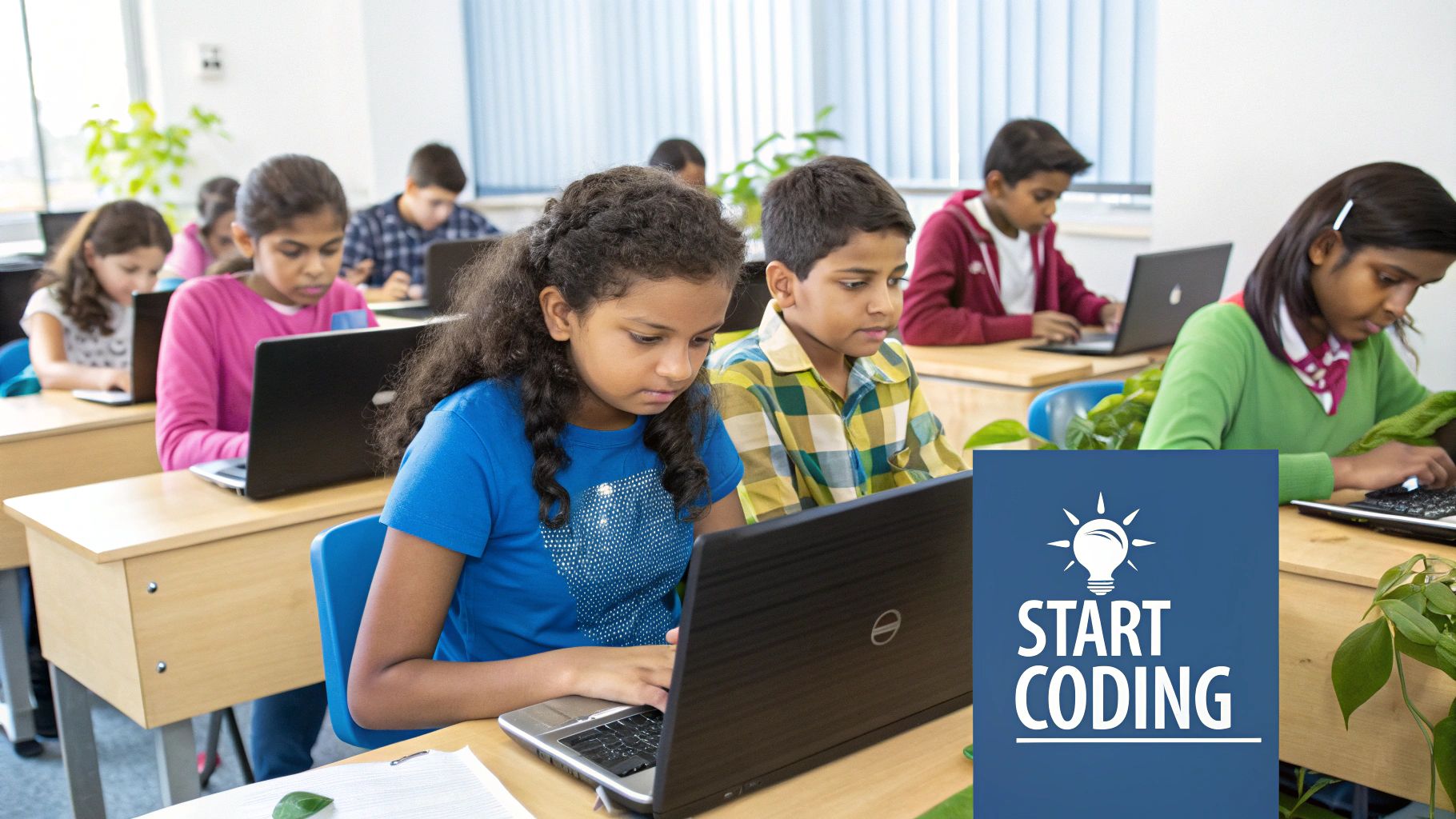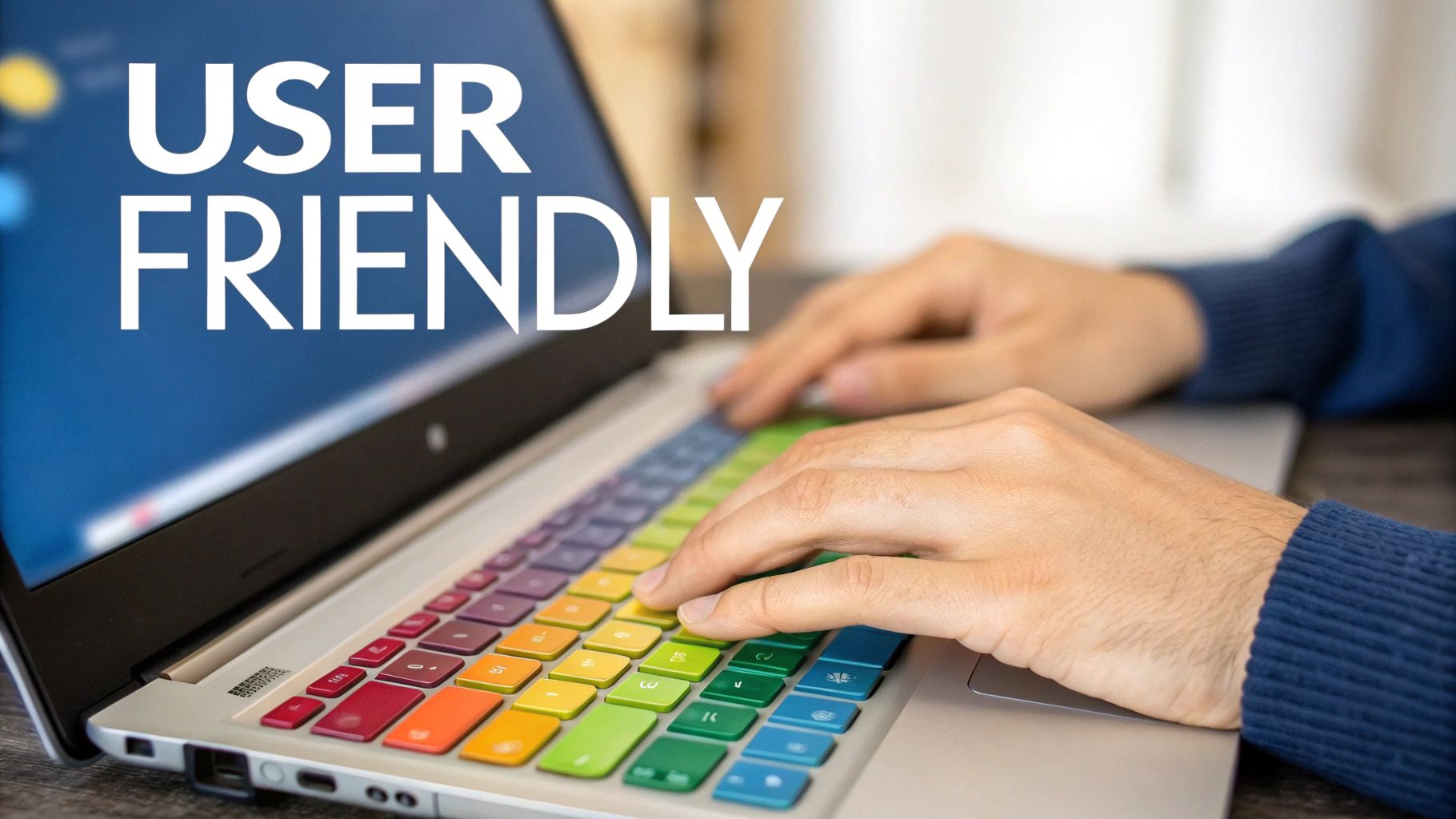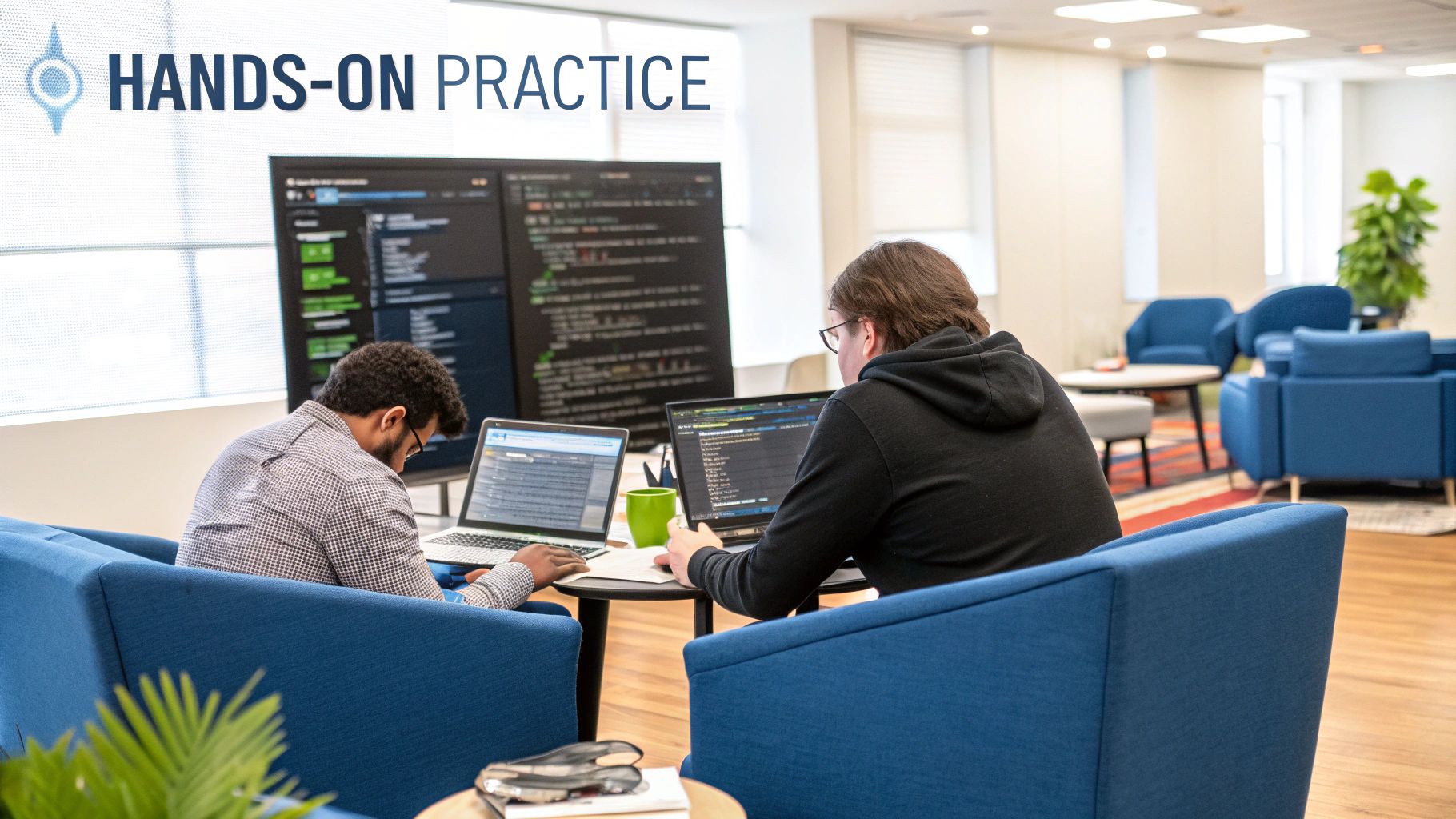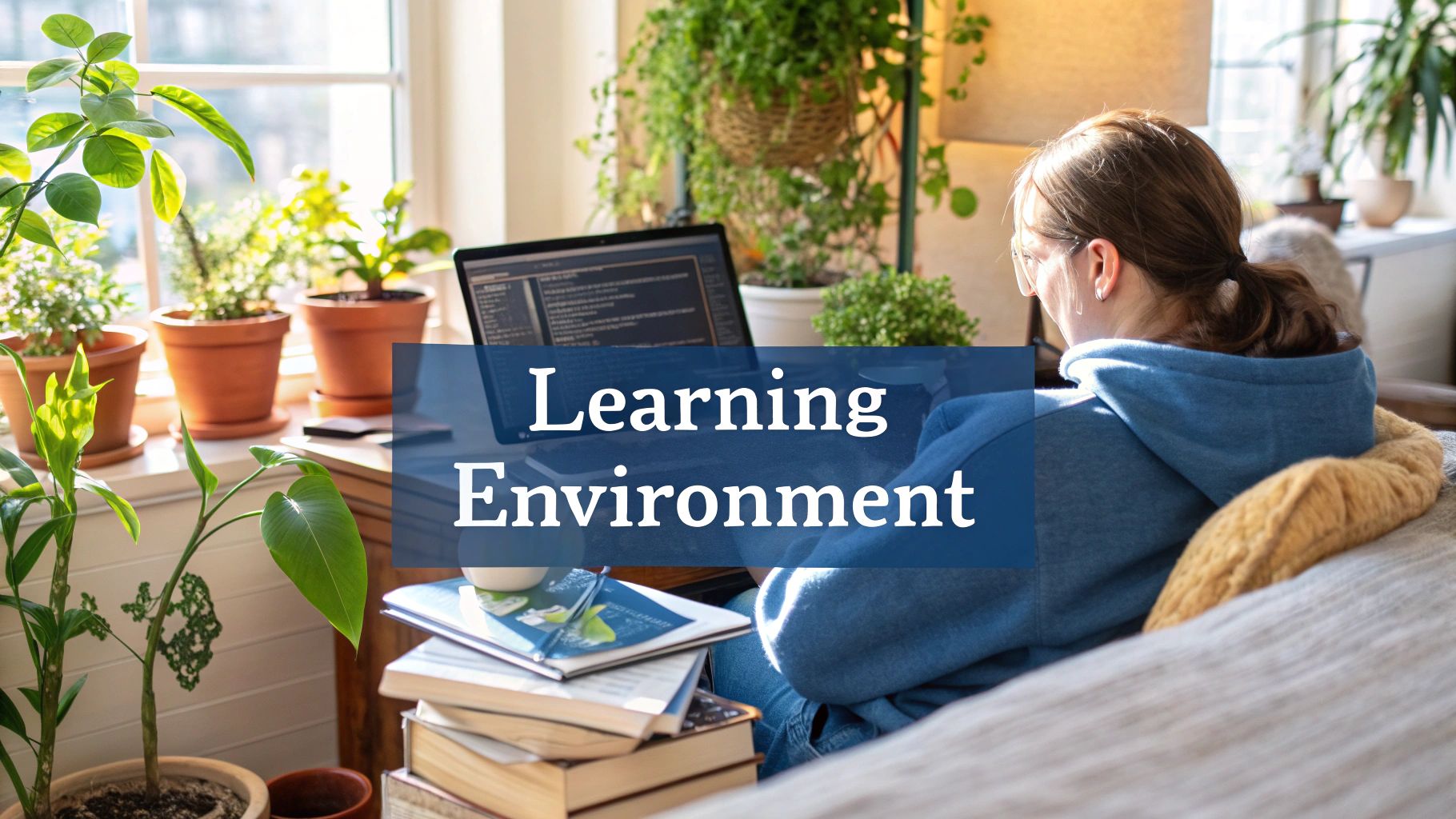Best Coding Language for Beginners: A Step-by-Step Guide to Launching Your Programming Career
Why Python Dominates the Beginner Programming Landscape

Python stands out as the go-to choice for people just starting to code. This makes perfect sense when you look at what makes Python so good for beginners. Let's break down why Python often tops the list of recommended first programming languages.
Readability and Simplicity: A Gentle Introduction to Code
The way Python is written makes it feel almost like reading regular English. While other languages pile on symbols and complex rules, Python keeps things clear and straightforward. Want to print "Hello, world!"? Just type print("Hello, world!") – that's it. This simple approach means beginners can focus on learning core programming ideas instead of getting stuck on complicated syntax rules. When you can read and understand code easily, you're more likely to stick with learning.
Clean Coding Habits From the Start
Python doesn't just make code easy to read – it actually requires you to write clean, organized code from day one. The way you indent your code isn't just for looks – it's part of how Python works. This means beginners naturally learn good coding habits that help them write better code in any language. For example, when you write an if-statement in Python, the proper spacing is built right into how the code works. This makes finding and fixing mistakes much easier, which is exactly what beginners need.
A Thriving Community and Abundant Resources
Every new programmer hits roadblocks – it's just part of learning. The good news is that Python has one of the most helpful programming communities out there. When you get stuck, you can find answers on sites like Stack Overflow or the official Python forums. There are tons of free tutorials, courses, and guides made just for beginners. Whether you learn better by watching videos, reading docs, or trying things hands-on, you'll find resources that work for you.
Simplicity Doesn't Mean Limited Potential
While Python is easy to start with, it's definitely not just for beginners. Big companies use Python for serious work in data science, websites, apps, and artificial intelligence. This means learning Python can lead to real job opportunities. For instance, data analysts use Python tools like NumPy and Pandas every day to work with large datasets. Starting with Python gives you a solid foundation that can grow into any programming career you want to pursue. You're not limiting yourself by choosing an "easy" language – you're starting with a tool that can take you from beginner to professional.
Mastering R: Your Gateway to Data-Driven Programming
After exploring Python's versatility, let's look at another excellent language for beginners: R. While Python handles a broad range of tasks well, R stands out specifically in data analysis and visualization. If you're fascinated by finding patterns in complex data or creating clear, compelling charts that reveal hidden insights, R could be your ideal starting point.
Unlocking the Power of Statistical Computing
At its core, R is a specialized environment built for statistical work. From day one, you'll have access to powerful tools designed specifically for working with data. This focused approach means you can dive straight into learning statistics without getting lost in general programming concepts. R comes with an extensive library of packages – pre-built modules that add specific capabilities. These packages make it simple to perform complex statistical operations, even as a beginner. For instance, you can analyze large datasets or run advanced statistical tests with just a few lines of code.
Visualizing Data With Ease
One of R's most compelling features is how easily it turns numbers into visuals. Using tools like ggplot2, you can create professional-quality graphs that clearly communicate your findings. The immediate visual feedback makes learning more engaging – you can quickly see how changes in your code affect the final output. This hands-on approach helps reinforce key concepts as you learn.
A Supportive Ecosystem for Data Enthusiasts
Just like Python, R has a welcoming and active community. When you run into challenges, you'll find plenty of helpful resources and experienced users ready to offer guidance on forums and discussion boards. This support network proves invaluable when tackling complex data analysis concepts. R's focused environment helps new users avoid common mistakes in data handling and statistical interpretation, building a strong foundation for more advanced work. While R may seem more specialized than Python at first glance, its targeted approach offers a direct path into data analysis. For those excited about working with data, R provides an accessible entry point into the field of data-driven programming.
Building Modern Websites: HTML, CSS, and JavaScript Essentials
Now that we've explored data-focused programming languages, let's dive into web development – specifically the core technologies that power the modern web. If you want to build interactive, visually appealing websites, you'll need to master three key languages: HTML, CSS, and JavaScript. These languages work together to create engaging web experiences, making them perfect for beginners since you can see your code's results instantly in the browser.
Structuring Content With HTML: The Foundation of Every Webpage
HTML (HyperText Markup Language) provides the basic structure for all web content. Think of it like building the frame of a house – HTML tags define where each piece goes, from headings and paragraphs to images and links. For example, you use <p> tags to create paragraphs and <h1> tags for main headings. This straightforward approach to organizing content makes HTML an ideal first language for new coders to learn.
Styling With CSS: Transforming Design Visions Into Reality
While HTML handles structure, CSS (Cascading Style Sheets) controls how everything looks on screen. CSS lets you customize colors, fonts, layouts, spacing and more. It's like painting and decorating that house frame – you can completely change how elements appear without touching the underlying HTML. For instance, a few lines of CSS can change text colors, add beautiful backgrounds, or create responsive layouts that work on any screen size. Being able to see these visual changes instantly makes learning CSS especially rewarding.
Bringing Websites to Life With JavaScript: Adding Interactivity and Dynamic Behavior
JavaScript takes static web pages and makes them interactive. It handles all the dynamic elements that respond to user actions – form validation, image sliders, games, and more. Going back to our house analogy, JavaScript is like adding electricity and plumbing – it makes everything functional and responsive. You can use it to update content without reloading the page, create animations, or build complex interactive features. This ability to create engaging experiences makes JavaScript particularly satisfying for beginners to learn.
Combining Forces: The Synergy of HTML, CSS, and JavaScript
These three languages complement each other perfectly: HTML for structure, CSS for style, and JavaScript for interactivity. For new developers, this clear separation of concerns makes learning easier since you can focus on mastering one language at a time. As you progress, you'll see how they work together to create polished, professional websites. The immediate visual feedback you get while coding helps reinforce concepts and encourages experimentation. This combination of visual learning and practical results makes web development an engaging way to start your coding journey.
Making Your First Programming Language Choice Count
Starting your coding journey begins with an important decision – which programming language to learn first. With dozens of options available, this choice can feel daunting. But rather than searching for the "perfect" language, focus on finding one that matches your goals and interests. Taking time to make an informed choice now will save you frustration and keep you motivated as you learn.
Aligning Your Choice With Your Goals
Before diving in, think carefully about what you want to create with code. Are you interested in building websites? HTML, CSS, and JavaScript form the foundation of web development. Want to analyze data and build models? Python or R would serve you well. Start by mapping out your interests – this will naturally narrow down your options to languages that can help you achieve those goals.
Considering the Learning Curve
Different languages pose different challenges for beginners. Python is popular with new coders because its clear, readable syntax helps you grasp core programming concepts without getting caught up in complex rules. But even beginner-friendly languages take time to master. For example, R is perfect for data analysis but requires learning specialized statistical concepts alongside the syntax. Consider both what you want to build and how much time you can dedicate to learning.
Job Market Demand and Real-World Applications
While you should choose a language you're excited to learn, it's smart to consider the job prospects too. Python skills are in high demand due to its use in data science, artificial intelligence, and other growing fields. JavaScript remains essential for web development roles since it powers interactivity on most websites. Look at job postings that interest you to see which languages employers request most often. This research helps ensure your learning efforts align with real career opportunities.
Dispelling Common Misconceptions
Many beginners worry that starting with an "easy" language will limit their options later. This simply isn't true. Learning your first language, whether it's Python or something else, teaches you universal programming concepts that make picking up additional languages much easier. Rather than getting stuck on finding the "best" first language, choose one that genuinely interests you. Your enthusiasm will help you push through challenges and build momentum as you learn. The most important thing is to start coding and stick with it.
Building Rock-Solid Programming Foundations
Picking a first programming language is just the beginning. What really matters is understanding the core concepts that work across all languages. These fundamentals shape how you think about solving problems with code. Rather than just memorizing syntax, learning to think like a programmer gives you skills you can apply anywhere.
Core Programming Concepts: The Building Blocks of Success
Whether you start with Python, R, or JavaScript, certain key concepts remain the same. Let's explore these essential building blocks:
-
Variables and Data Types: Think of variables as containers that hold different kinds of information. Just like you wouldn't store soup in a filing cabinet, different types of data need different containers. Numbers, text, and true/false values each have their own format. For example, storing a username needs a different approach than storing someone's age.
-
Control Flow: This is how your program makes decisions and repeats tasks. Using tools like
ifstatements and loops, you can write code that responds to different situations. It's like creating a flowchart that guides your program through various scenarios based on the information it receives. -
Functions: These are like recipes – write the instructions once, use them whenever needed. Functions help keep your code clean and organized. For instance, you might write a function that converts temperatures from Fahrenheit to Celsius, then use it throughout your program.
-
Data Structures: These are ways to organize information effectively. Lists, dictionaries, and sets each serve different purposes. Choosing the right one makes a big difference – finding an item in a dictionary is much quicker than searching through a long list.
Debugging: Turning Errors Into Learning Opportunities
Every programmer faces bugs – it's part of the process. Learning to fix these issues helps you become a better problem solver. Here's how to approach debugging:
-
Reading Error Messages: These messages aren't just random text – they're clues that point to specific problems. Learning to understand them helps you fix issues faster.
-
Using a Debugger: This tool lets you pause your program and look at what's happening step by step. It's like having X-ray vision into your code's inner workings.
-
Testing: Check your code regularly, even small pieces. Finding problems early saves time and headaches later. Think of it as proofreading your work as you go.
Building Projects: Applying Your Knowledge and Showcasing Your Skills
The best way to learn programming is by creating real projects. Start simple and work your way up. Even basic projects teach valuable lessons about how code works in practice. Here's how to approach project work:
-
Planning: Before writing any code, sketch out what you want to build. What should your program do? What features will it need? This roadmap keeps you focused.
-
Breaking Down the Problem: Split big tasks into smaller pieces. Instead of trying to build an entire game at once, start with just moving a character on screen.
-
Iteration and Refinement: Get something working first, then make it better. Each improvement teaches you something new about programming.
By mastering these basics – core concepts, debugging skills, and hands-on projects – you'll build a strong foundation for learning any programming language. This practical knowledge helps you tackle more complex challenges as you grow as a programmer.
Navigating Learning Resources and Building Your Support Network
Once you've chosen a programming language to learn, finding quality learning materials and building connections in the coding community are essential next steps. The number of online coding tutorials can feel overwhelming at first, but having a clear strategy helps. Let's look at proven ways to find resources and build relationships that will support your programming journey.
Discovering Effective Learning Methods
Everyone learns differently, so it's worth trying various approaches to find what works best for you. Some people thrive with hands-on practice, while others prefer structured lessons. The key is experimenting with different methods until you find your groove.
-
Interactive Coding Platforms: Sites like Codecademy, freeCodeCamp, and Khan Academy offer practical coding exercises with immediate feedback. Their bite-sized lessons make complex topics easier to digest and practice.
-
Structured Online Courses: Platforms like Coursera, edX, and Udemy provide full courses with video lectures and assignments. For example, you might take an 8-week Python course that includes weekly quizzes and projects. Many courses offer certificates that can help with job applications.
-
Open-Source Contributions: Once you know the basics, working on open-source projects on GitHub gives you real coding experience. You'll learn how larger projects work and pick up best practices from other developers. For instance, you could start by fixing small bugs or improving documentation.
-
Books and Documentation: Though online tutorials are popular, programming books and official docs often explain concepts more thoroughly. They're great references when you need detailed information about specific language features or advanced topics.
Building Your Support System
Learning to code is challenging, but you don't have to do it alone. Connecting with other programmers, both beginners and experts, can speed up your learning and keep you motivated when things get tough.
-
Online Communities: Technical forums like Stack Overflow and programming subreddits offer places to ask questions and share knowledge. When you're stuck on a problem, these communities can help you find solutions and understand where you went wrong.
-
Local Meetups and Workshops: In-person coding events let you meet developers in your area, learn new skills, and get feedback on your work. Many cities have regular meetups for specific languages or technologies where you can find study partners and mentors.
-
Mentorship: Working with an experienced programmer can dramatically improve your learning. A good mentor helps you avoid common pitfalls, suggests learning resources, and shares industry insights. Look for mentorship programs through coding bootcamps or professional organizations.
By combining these learning resources and building connections in the programming community, you'll create a strong foundation for your coding journey. As you progress, remember to help other beginners too – teaching others reinforces your own knowledge and makes the community stronger.
For more programming tips and tech insights, check out DebugBar.com. The site covers everything from practical coding guides to updates on software tools and technology trends.



Comments
Leave a comment